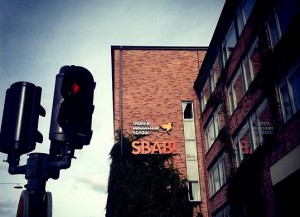SCBC back after deposit drive, plans yearly euro benchmarks
Oct 2nd, 2014
SCBC sold its first euro benchmark in three and a half years on Tuesday, a Eu1bn (Skr9.1bn) seven year that is understood to be the first soft bullet covered bond out of Sweden, and an official at the issuer said it will now be returning to the euro-denominated market on a yearly basis.
 The last euro benchmark from the Swedish Covered Bond Corporation (SCBC) was in April 2011 and the issuer has been absent from the public covered bond euro market for so long because it has been focused on building up its deposits, said Louise Bergström, head of investor relations at SBAB (SCBC’s parent). These have risen from around Skr5bn of the bank’s funding in 2011 to almost Skr60bn, equivalent to 17% of its balance sheet, today.
The last euro benchmark from the Swedish Covered Bond Corporation (SCBC) was in April 2011 and the issuer has been absent from the public covered bond euro market for so long because it has been focused on building up its deposits, said Louise Bergström, head of investor relations at SBAB (SCBC’s parent). These have risen from around Skr5bn of the bank’s funding in 2011 to almost Skr60bn, equivalent to 17% of its balance sheet, today.
“We’ve had a tremendous growth of deposits and haven’t really needed to come to the public euro market,” she told The Covered Bond Report. “It has led to less reliance on the capital markets, and that is something that is well received by the regulator, by investors and of course also by the rating agencies.”
She added that the domestic market has also provided more attractive funding than was available in euros.
However, the issuer has maintained its marketing efforts internationally and Bergström said that SCBC is now looking at returning to the euro market on a yearly basis — it has Eu1bn redemptions due in 2015, 2016 and 2017.
The mandate for Tuesday’s deal was announced on Monday and Bergström said the issuer had been looking at the market for some time. However, the issuer wanted to meet some investors it had not seen for some time and, with the industry events in Vienna last week, this week was eyed as a potential issuance window, she added, with the issuer also taking into account the timing of ECB announcements.
The Eu1bn seven year new issue was priced at 1bp over mid-swaps yesterday on the back of a Eu1.5bn order book after leads Bank of America Merrill Lynch, Barclays, Citi, Danske and RBS had gone out with IPTs of mid-swaps plus the low to mid-single digits, then moved to guidance of the mid-swaps plus 2bp area.
“From an issuer’s perspective, they are very tight levels,” said Bergström. “We are extremely pleased with the transaction and believe that the market is, too.
“There was the potential to maybe go a little bit tighter, to mid-swaps flat,” she added, “but it is always important to leave something on the table for investors and as this is not a one-off we are investing in a long term relationship with them.”
According to a syndicate official at one of the leads, the deal is the tightest Nordic seven year issue since 2007.
The deal came in the same week that fellow Scandinavian DNB priced a Eu1.25bn five year covered bond benchmark at 3bp through mid-swaps.
“Although not surprising, it is great to see just how far Draghi’s initial announcement is spilling over into non-Eurozone names,” said Robert Chambers, FIG syndicate manager at Crédit Agricole CIB. “The pricing levels observed this week were very competitive for these issuers whilst the level of granularity in the books remained strong.”
Bergström said that the choice of a seven year maturity was to help the issuer extend duration.
“We have been looking at extending our maturity profile and have been doing so over recent years,” she said.
Issuance in the domestic market only goes out to five years but Bergström said that the funding level achieved on the seven year euro could be considered to be almost on a par with domestic levels, and that the seven year part of the curve offered better value versus euros than five years would have.
The benchmark used a soft bullet structure and according to Bergström it is a first for the Swedish market.
“We have had it in our documentation for some time and we have seen that the market is more or less going in that direction,” she said, “and we always look at keeping up with the latest developments.”
She said that some investors view the structure positively but others have some doubts, including some who consider it as an eight rather than seven year maturity. Some other Swedish issuers have provisions for soft bullet issuance in their documentation, according to Bergström, who said that whether or not it takes off in the Swedish market is a case of “wait and see”.
Banks were allocated 49%, asset managers 30%, SSAs 13%, insurance companies and pension funds 7%, and others 1%. Germany, Austria and Switzerland took 57%, France 12%, the UK and Ireland 11%, Nordics 8%, the Benelux 4%, Italy 3%, Asia 3%, and others 2%.
The new issue comes shortly after Per Tunestam, SBAB’s treasurer, left SBAB after 17 years. Fredrik Jönsson, who was previously head of funding, has taken over as head of treasury.
“Per has been one of the driving forces behind the Swedish covered bond product, and his skills and expertise will be missed,” said Jönsson. “The colleagues at SBAB wish him all the best in future challenges.”








